Almost every investor has heard the expression The Trend is Your Friend. This comes as no surprise, given that momentum is the premier stock market anomaly. And it is only logical that there is an infinite number of strategies attempting to profit from this anomaly. What’s less obvious is that these strategies are far from identical. They differ in the assets traded and, more importantly, how they measure and rank momentum. In this post, we take an in-depth look at a momentum strategy improving its decision-making quality through better noise reduction.
Prior Art
Before we begin, we’d like to point readers to some prior art. Scott M. Juds’ fabulous book Conquering the Seven Faces of Risk heavily inspired our work described in the following. Juds’ book describes most of the principles used here with much detail and full-color charts. Further, Juds offers his SectorSurfer® portfolios based on these methods through his company SumGrowth Strategies.
We thoroughly enjoyed reading Conquering the Seven Faces of Risk. The book does an excellent job explaining the merits of Juds’ key ideas and putting them into context. However, the book falls short in offering sufficient detail to allow readers to reproduce his strategies. Consequently, our methodology and implementation are undoubtedly similar to Juds’, but almost certainly not identical.
Volatility Drowns Trend
Every day we are bombarded with news, and many if not all of them somehow affect prices in the stock market. The never-ending chatter creates volatility in the markets, and this volatility makes it harder to identify and measure the trends we are looking for. The effect of volatility on trend is quite similar to how static on an old TV makes it harder to follow your favorite program.
Looking at some numbers helps to understand how much volatility obscures the trend we are after. Between 1990 and today, the S&P 500 had a total annualized return of about 8.7%. Over the same period, volatility was approximately 20.8%. As we see, volatility moves prices more than twice as much as the trend does. It is, therefore, fair to say that volatility drowns the trend. And because of this, volatility makes it harder for our trading system to measure trends accurately and make reliable decisions regarding the assets to hold.
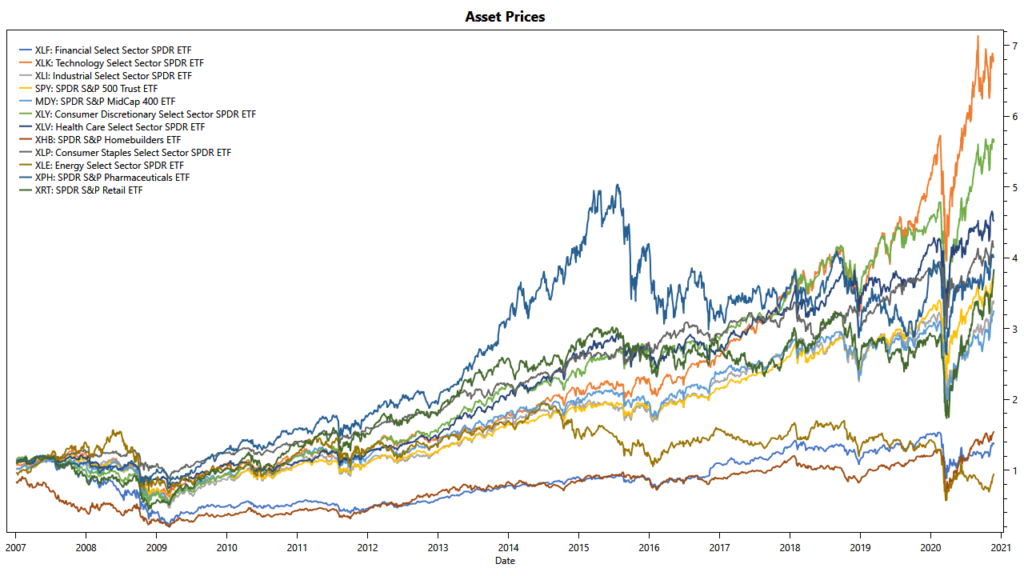
Noise Reduction
Stock prices are described by discrete time series, much like, for example, digital audio data. And what volatility does to our stock prices is quite similar to what noise does to audio. Therefore, it is not too far-fetched to apply some of the same signal processing to our stock prices as we often do in the audio world.
Most momentum strategies use increasingly aggressive filters to reduce the adverse effects of volatility. In particular, they consider momentum over longer periods, often six to twelve months. The audio world’s equivalent is to get rid of annoying hiss by reducing treble – and ending up with a muffled sound. Similarly, there are consequences to observing momentum over longer periods: Our strategy becomes less responsive and has more difficulties adapting to the ever-changing markets. We aim to be better than this.
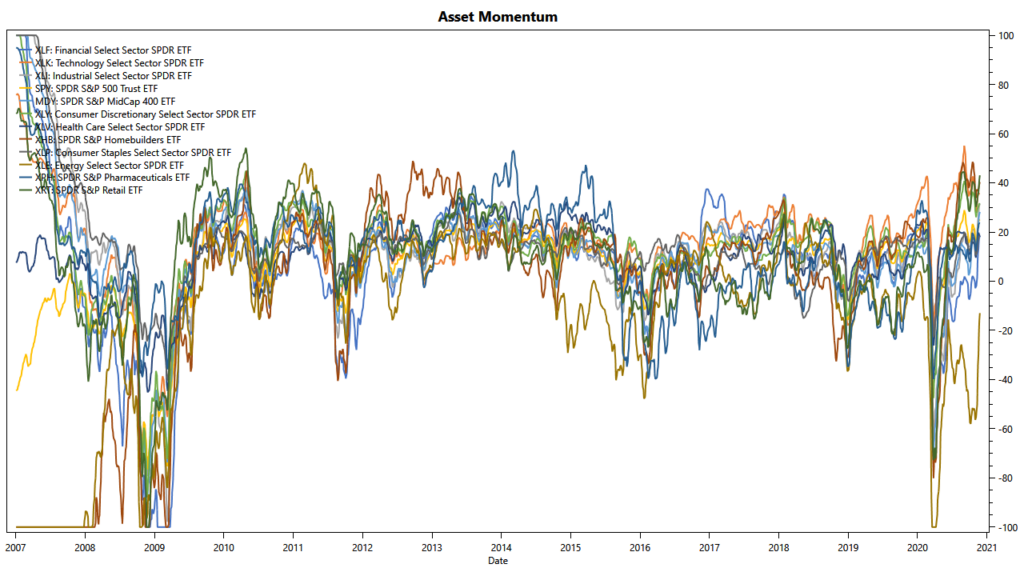
When we look at the asset prices above, we can see that each sector ETF follows its own path, and ultimately they all lead to very different long-term results. This is the momentum we’d like to capture. But when we look at the asset momentum, it is a tangled mess of lines, and we often have a hard time identifying a clear leader.
However, what stands out is that the momentum often seems to move in lockstep. In the short term, the various assets are highly correlated. In signal processing, we call this common-mode noise, and we have a good chance of removing most of it.
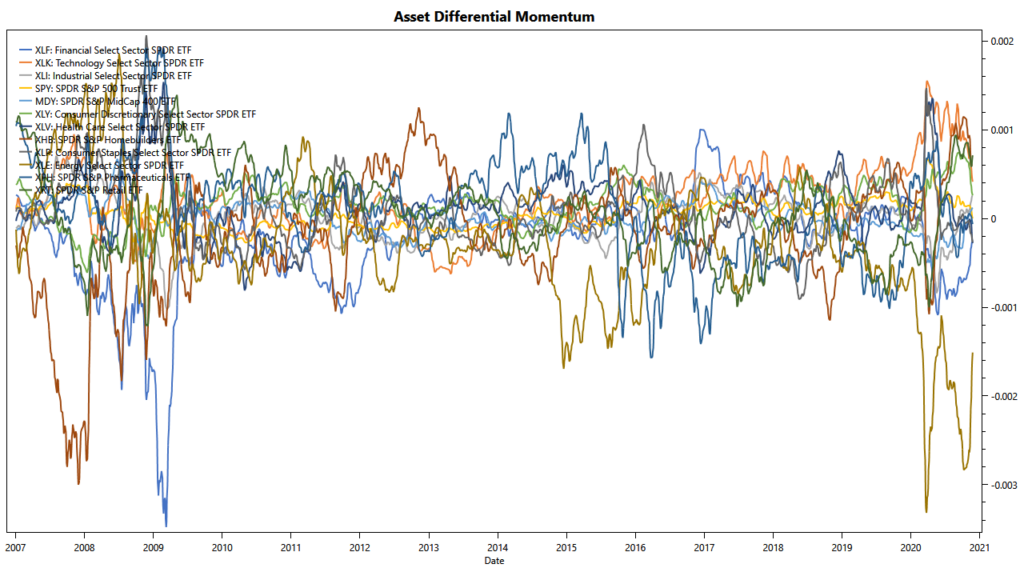
By combining all our assets into an equal-weighted basket, we can create a benchmark. Next, we can measure each of our asset’s momentum relative to this benchmark. In doing so, we transition from a measurement of absolute momentum to one of differential momentum. Simply put, we are no longer looking at the absolute returns but how much better (or worse) than our benchmark each asset performed. The chart shows a significant improvement. Even without aggressive filtering, we can now clearly identify leaders and laggards.

By applying some additional filtering and carefully adjusting the filter parameters, we can further clean up the picture. Based on this chart, our momentum strategy can now confidently identify the best assets to hold. As a bonus, we see that the leadership positions no longer change that often – making sure we don’t need to trade too frequently.
In comparison to typical momentum strategies, we’ve come a long way. For once, our momentum signals carry much less noise. Consequently, there is typically no doubt which asset is leading. And further, we got to this point with much shorter filter periods. Where typical momentum strategies use 12-months periods, we have crystal-clear signals at about 3-months. To sum this up: our decisions are better, and we can make them much faster.
Walk-Forward Optimization
But how do we choose the exact filter parameters? Of course, we can run brute-force optimization and then select the best set. For obvious reasons, this parameter set will depend on the assets traded. But even worse, we have to anticipate that the parameters fluctuate over time and that today’s best parameters don’t hold in the future.
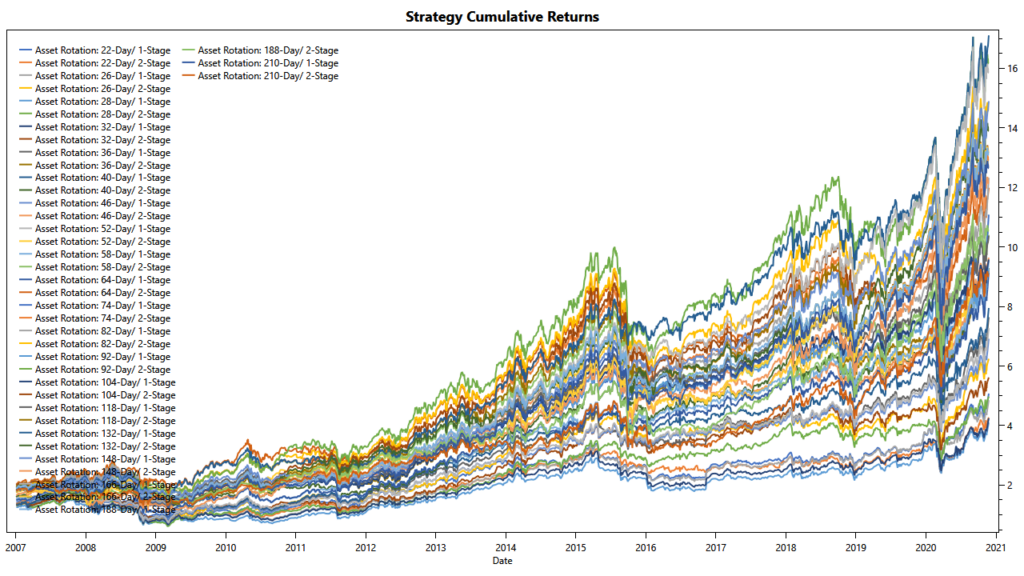
The chart above shows how the filter parameters affect the cumulative strategy returns. While we can see that ultimately some parameter combinations lead to higher returns than others, we can also see how the leaders change over time and with the market conditions.
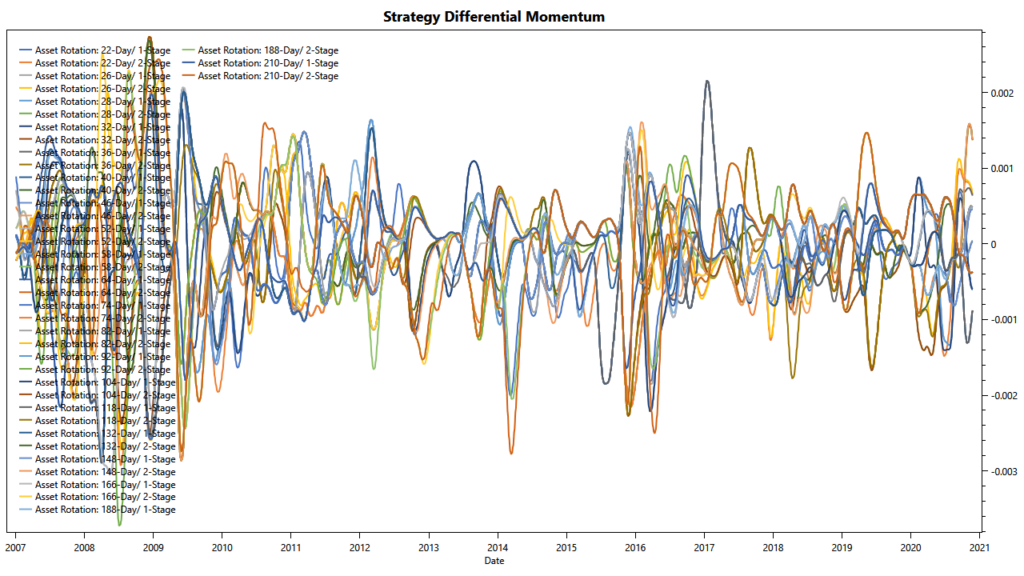
To address this issue, we use a similar procedure as outlined above for selecting the best assets. By comparing the strategy returns to a benchmark, we can eliminate the common-mode noise and extract the momentum signals with little filtering. Even though the filters we used react fairly fast, we can see that it typically takes about one year for the best parameter set to degrade to average. Therefore, we don’t need to adjust our parameters too often: once every quarter seems plenty enough.

Bear-Market Strategies
The resulting strategy already has handsome returns. But in our quest to reduce noise, we have given up something important. Our noise-reduction technique hinges on eliminating common-mode noise as it appears between highly correlated assets. Consequently, we cannot easily add uncorrelated or even negatively correlated assets, like gold or treasuries. This limitation leaves us vulnerable in times of recession.
We address this issue by implementing a separate bear-market strategy. While following all of the same principles outlined above, this strategy trades a wide array of debt instruments, including treasuries, municipal bonds, corporate bonds, and high-yield bonds.

We combine our bull-market and bear-market strategies using a simple switching method based on the market sentiment. We determine the prevailing market sentiment through a simple voting mechanism between multiple market outlooks:
- S&P 500 momentum
- S&P 500 volatility
- Economic growth, measured through unemployment
This scheme is similar to Philosophical Economic’s Growth Trend Timing. By adding volatility as a third input, we can speed up reaction time to market melt-downs.
The chart above shows that from 1990 to today, this method has done an admirable job of exiting stocks before markets turn sour. Equally important, this method has been able to keep up with the strong bull markets in the 1990s and after the 2008 recession.

By calculating the ratio between the S&P 500 index and our strategy’s equity, we can see this even more clearly in the so-called tracking error. Most of the time, the ratio stays perfectly flat, indicating returns identical to the S&P 500. In times of turmoil, especially the 2000 dot-com crash, the 2008 housing-bubble, and the 2020 pandemic, we see how exiting to bonds helped preserve the capital.

A Modular Approach
With all components in place, it is time to put everything together. The strategy combines several different concepts, which interact with each other. To keep the code manageable, we are using a modular approach. Doing so allows us to implement each idea as a separate strategy and then combine the concepts the same way we create our All-Stars meta-Portfolios.
The diagram above shows how our strategy switches between separate strategies for bull and bear markets at the top-level. We are using a lazy portfolio during bull markets, combining a rotation of Sector ETFs with one for Stylebox ETFs. There are three sector rotation blocks in total, each governed by its own walk-forward optimization.
Having everything wired up, we need to give the strategy a name. In essence, the strategy runs tournaments between almost equally capable contenders. Therefore, we decided to go with a sports analogy. Say hello to TuringTrader’s Round-Robin.
Round-Robin Performance
Of course, we didn’t build all of this for the love of technology. Ultimately, the only thing that matters is performance. The chart above shows Round-Robin‘s overall equity curve. As we can see, the strategy handled the recessions of 2008 and 2020 very well. In between, the strategy shows drawdowns about on-par with the S&P 500.
The 1-year rolling returns show that most of the time, Round-Robin has a substantial edge over the S&P 500, with only very few short periods where the strategy is trailing its benchmark. Even better, the rolling returns rarely dip into negative territory.
By charting the strategy’s equity curve relative to the S&P 500, we can see how Round-Robin continuously grows faster than its benchmark, with no flat tires on the way. During recession periods, the strategy makes further notable gains over the index.
Summary
In summary, we find that Round-Robin is a great way to participate in the stock market. The strategy has a continuous edge over the market while avoiding the risks involved with picking individual stocks. Thanks to its sentiment-switching, Round-Robin can mitigate most of the pain involved with going through recession periods. Because Round-Robin primarily invests in the stock market, investors should consider combining it with other strategies to achieve diversification across different asset classes.
SectorSurfer® is a trademark of SumGrowth Strategies, LLC.
